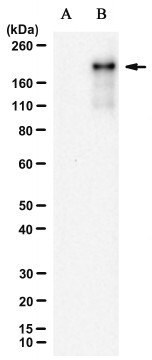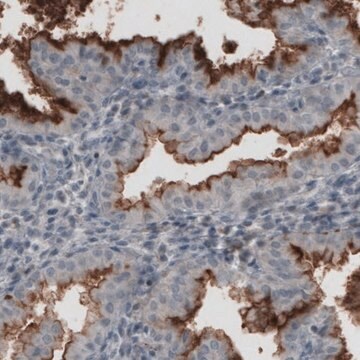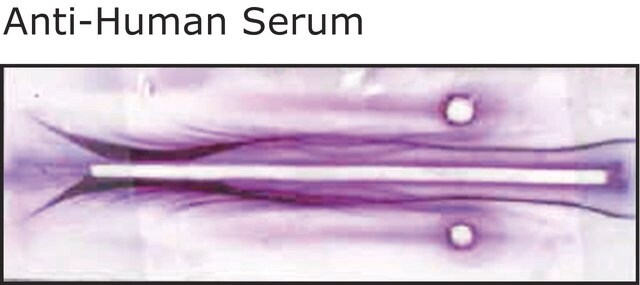MABF3083
Anti-SARS-CoV-2 Delta Spike Antibody, P681R Antibody, clone 4C5-B2
Sinônimo(s):
S glycoprotein Delta P681R, Spike glycoprotein Delta P681R
About This Item
Produtos recomendados
fonte biológica
mouse
Nível de qualidade
forma do anticorpo
purified antibody
tipo de produto de anticorpo
primary antibodies
clone
4C5-B2, monoclonal
peso molecular
calculated mol wt 141.18 kDa
observed mol wt ~200 kDa
purificado por
using protein G
reatividade de espécies
virus
embalagem
antibody small pack of 100 μL
técnica(s)
western blot: suitable
Isotipo
IgG2aκ
sequência de epítopo
Extracellular domain
nº de adesão UniProt
temperatura de armazenamento
2-8°C
Informações sobre genes
vaccinia virus ... S(43740568)
Especificidade
Imunogênio
Aplicação
Evaluated by Western Blotting in lysate from HEK293T cells transiently transfected with SARS-CoV-2 Delta spike B.1.617.2.
Western Blotting Analysis: A 1:500 dilution of this antibody detected SARS-CoV-2 Delta spike protein (P681R) in lysate from HEK293T cells transiently transfected with SARS-CoV-2 Delta spike B.1.617.2, but not in wild-type HEL293T cells.
Tested Applications
Western Blotting Analysis: A representative lot detected SARS-CoV-2 Delta spike protein (P681R) in Various whole cell lysates of HEK293T SARS-CoV-2 spike transfectants (Data courtesy of Dr. Stefan Schüchner and Dr. Egon Ogris (Max Perutz Labs, Medical University of Vienna, Austria).
Note: Actual optimal working dilutions must be determined by end user as specimens, and experimental conditions may vary with the end user.
Descrição-alvo
forma física
Reconstituição
Armazenamento e estabilidade
Outras notas
Exoneração de responsabilidade
Não está encontrando o produto certo?
Experimente o nosso Ferramenta de seleção de produtos.
Código de classe de armazenamento
12 - Non Combustible Liquids
Classe de risco de água (WGK)
WGK 1
Ponto de fulgor (°F)
Not applicable
Ponto de fulgor (°C)
Not applicable
Certificados de análise (COA)
Busque Certificados de análise (COA) digitando o Número do Lote do produto. Os números de lote e remessa podem ser encontrados no rótulo de um produto após a palavra “Lot” ou “Batch”.
Já possui este produto?
Encontre a documentação dos produtos que você adquiriu recentemente na biblioteca de documentos.
Nossa equipe de cientistas tem experiência em todas as áreas de pesquisa, incluindo Life Sciences, ciência de materiais, síntese química, cromatografia, química analítica e muitas outras.
Entre em contato com a assistência técnica






